Why are Agent Csat Skills Essential to Deliver Great CX?
SQM Group's research shows that 93% of customers using a call center expect to resolve their call reason on the first interaction. As a result, First Call Resolution (FCR) performance drives Customer Satisfaction (Csat) performance. For example, SQM's research shows for every 1% improvement in FCR, there is a 1% improvement in Csat.
Whenever a customer calls back to resolve a call (e.g., billing, claim, technical, order, and service) that was not resolved in the first interaction, 40% of them felt the agent could have done more to help them resolve the reason for their call. Most alarming is that Csat top box response drops 15% for every call a customer has to make to resolve the same call that was not resolved on the first interaction.
The bottom 15% of agents have twice as high customer defections due to their low Csat performance compared to the top 15%. In many cases, the call center is the last line of defense for a customer defecting. Many leaders believe that one of the call center's primary purposes is to help retain customers. SQM believes that most leaders are unaware of the differences between the best and worst-performing agents for Csat and call resolution and their impact on customer defections.
In most cases, when Csat improves, the source for the improvement is the customer satisfaction skills of the agents have been enhanced. A high-performing Csat agent will utilize customer satisfaction skills for the entire call to deliver a great CX.
Based on SQM Group conducting over 10 million surveys with customers who used an inbound customer service call center, we have determined the Top 10 Customer Satisfaction Skills That Agents Must Have to deliver great CX. Now let's examine the necessary top 10 Csat skills for call handling behavior standards and word choices or phrases that agents need to use to succeed.
Top 10 Customer Satisfaction Skills Agents Must Have
1. Call Resolution
The call resolution rate is the percentage of customers who resolved their inquiry or problem using a call center. For example, it might take two or more calls to be resolved. The benchmark average for call resolution is 88%. Call resolution is an important moment of truth that customer experiences during a call center interaction. In fact, call resolution and FCR metrics are the biggest drivers of Csat. SQM's Csat research shows the call center industry average Csat (top box response) benchmark rate is 78%. The call center industry standard for a good call resolution rate is 85% to 94%, and the Csat rate is 75% to 84%.
The world-class call resolution rate is 95%, the Csat rate is 85% or higher, and only 5% of call centers can achieve those world-class rates. At the heart of world-class Csat is how agents resolve calls. Resolving calls and having very satisfied customers requires agents to answer customer questions and solve their problems effectively. Therefore, call resolution and Csat are the most important metrics to hold agents accountable for their performance.
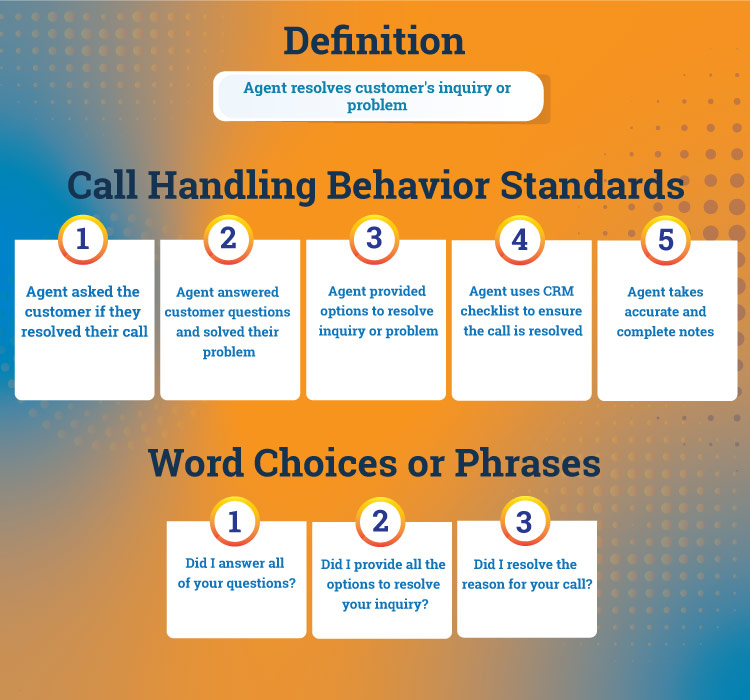
2. Ownership
The customer's problem should be attempted to be resolved by the frontline agent. Put differently, the agent who first hears the call owns the call. From a customer's perspective, they prefer to only talk to one agent. Designing CX is guided by operating principles such as reducing customer effort, taking ownership for resolving an inquiry or problem, making it a positive CX, and doing what is best for customers.
In addition, supervisors should be able to identify whether or not low-performing Csat agents have a skill or a will issue and what type of action needs to be taken with the low-performing Csat agents. Low Csat performing agents have will and skill issues. When a customer is dissatisfied with an agent, 62% of the time, it is due to a will issue, and 38% of the time is due to a skill issue. The agent taking ownership is essential for resolving calls and improving Csat.
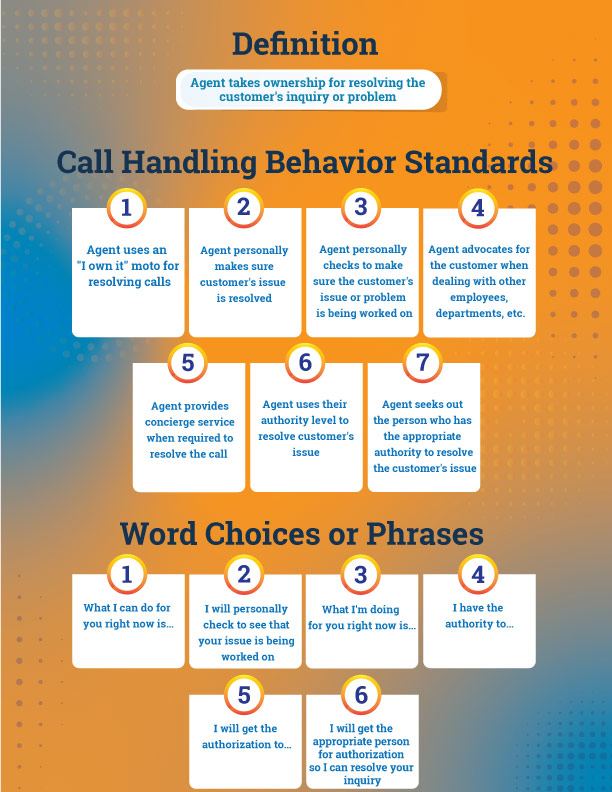
3. Helpful
Being helpful requires an agent to express and demonstrate a willingness to help customers. For example, letting them know they can help them, providing correct and complete information, focusing on the interaction, taking the necessary steps and time to help the customer, and educating them with solution options.
Usually, call center agents are the last line of defense for resolving a complex call or general inquiries. Unfortunately, 29% of calls are non-FCR interactions, and in 40% of those interactions, customers felt the agent could have done more to help them resolve the reason for their call. Using the below call handling helpful behavior standards will improve Csat.
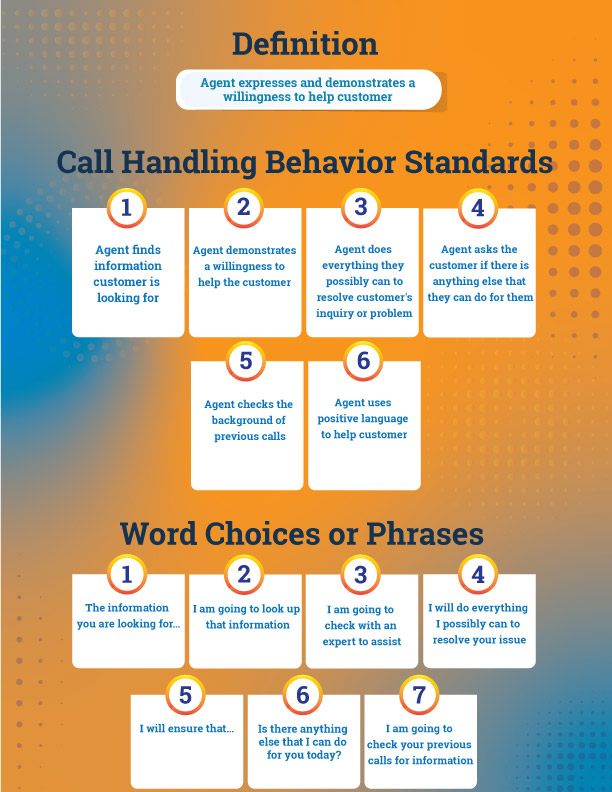
4. Knowledge
Again, SQM's research shows that 29% of the inbound calls result from the customer's call not being resolved on the first call for the average call center. For repeat calls, the agent is the source of error (SoE) for 38% of those calls, and for most call centers, the agent is the second biggest SoE for not achieving FCR and lower Csat.
Knowledge Management Tool (KMT) and Customer Relationship Management (CRM) apps are beneficial for assisting agents in resolving customer calls. Agent knowledge is central to a positive customer service experience to answer customer inquiries and provide all necessary information to resolve a customer's inquiry. If customers already knew, they would not need to call. Therefore, strong agent knowledge or access to the correct information the customer wants is a high driver for achieving great Csat ratings.
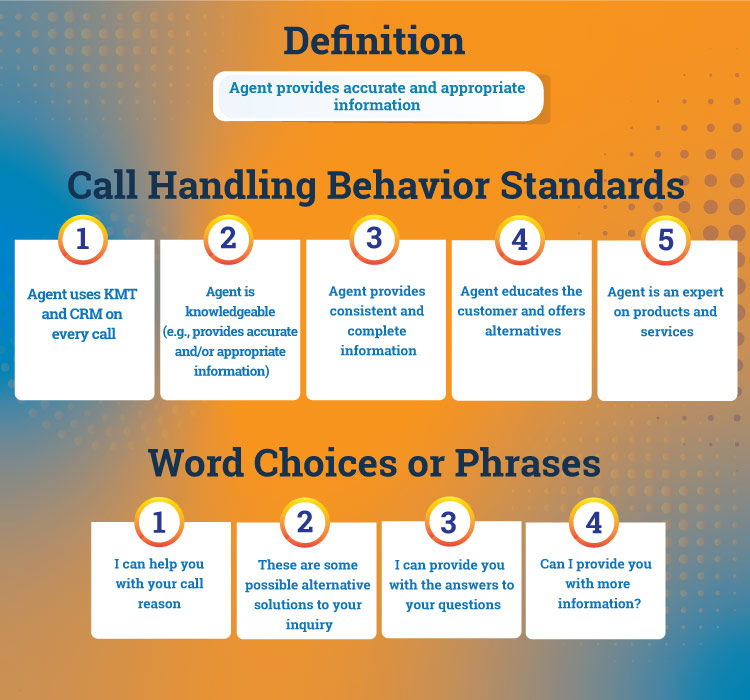
5. Empathy
Empathy is about call center agents understanding where the customers are coming from because they can put themselves in the customer's shoes. These agents show that they care about helping customers by being empathic.
Agent apologizes for a company's mistake or expresses empathy for the customer's situation. If a full agreement between the customer and agent cannot be reached on the issue or problem, try to seek a partial agreement on the issue or problem to defuse the customer's dissatisfaction. One of the best ways for an agent to ensure Csat when handling a difficult situation is for them to acknowledge the customer's point of view verbally.
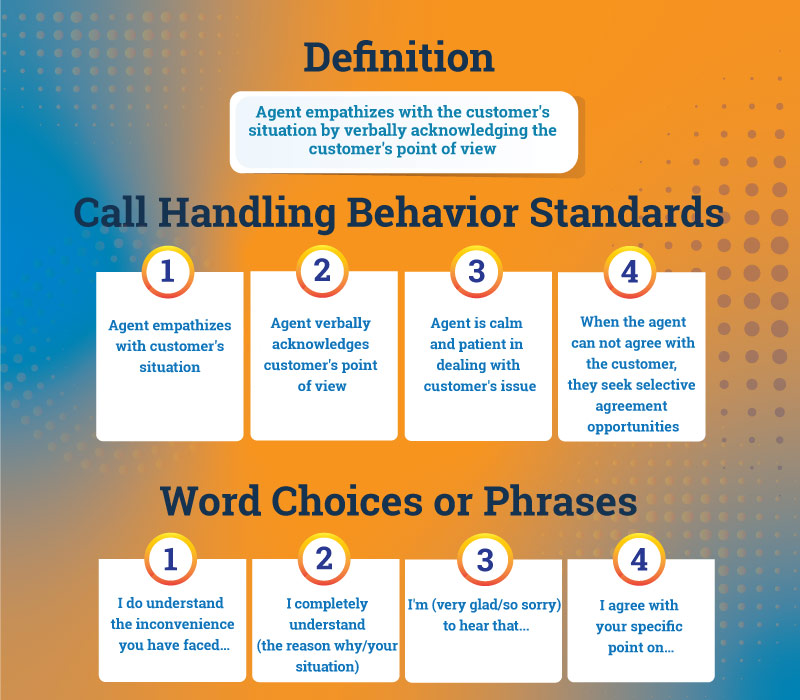
6. Build Rapport
Building rapport is essential because it allows agents and customers to connect and build relationships. When you build rapport with a customer, you're better placed to influence, share and learn. Therefore, customers will likely accept your ideas, share information, and collaborate to develop solutions.
Furthermore, the agent builds customer rapport by using a friendly, enthusiastic, warm voice tone, caring, patient, honest, engaging, and expressing appreciation for the customer's business. Building rapport isn't just about building relationships; it's often the foundation to delivering great customer service.
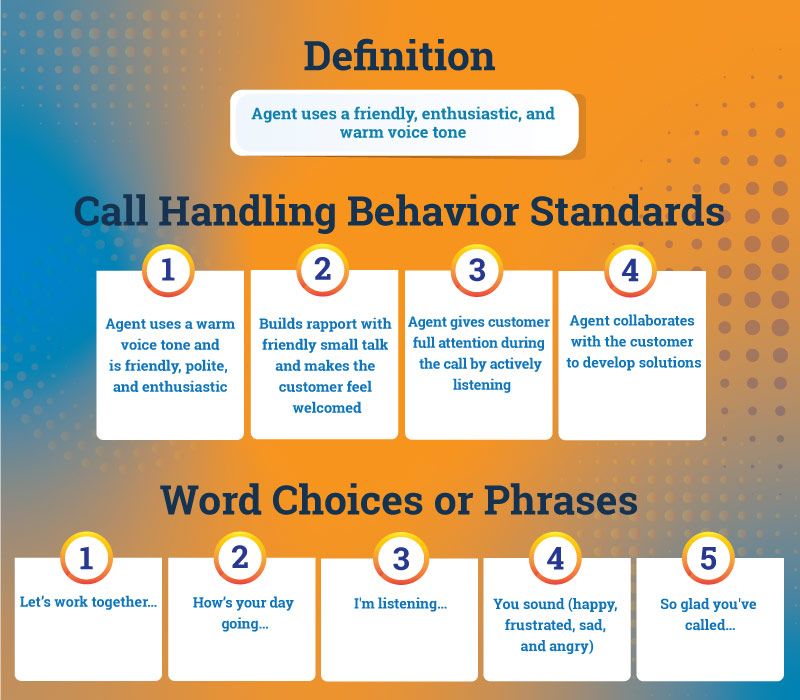
7. Communication
Effective agent communication is about exchanging ideas, opinions, knowledge, and data so the customer can understand the message with clarity and purpose. When we communicate effectively, both the agent and customer feel more satisfied. Do your agents need to improve their communication skills?
The below tips will help your agents avoid misunderstandings, grasp the real meaning of what's being communicated, and, most importantly, help improve Csat. Matching an agent's communication style to a customer's persona communication style will create a stronger connection and enhance their experience in doing business with your organization, resulting in higher call resolution and Csat ratings.
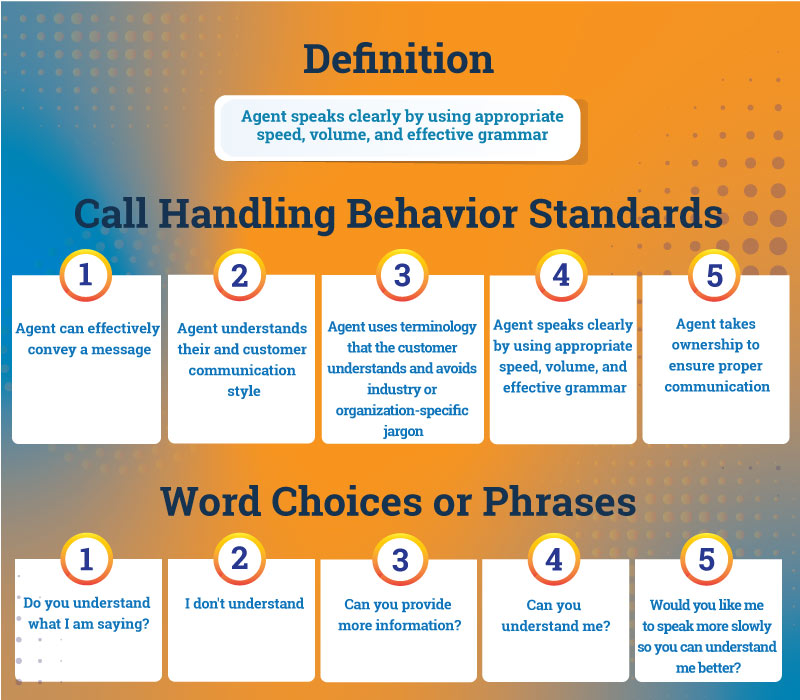
8. Listening
Listening is one of the most important skills an agent can have to achieve a high Csat rating. Unfortunately, research suggests that we only remember between 25% and 50% of what we hear. Of course, you hope the important parts are captured in your 25-50 percent, but what if they're not? Listening is a skill that an agent will benefit from improving. By becoming a better listener, an agent improves their ability to influence, persuade and negotiate. Moreover, an agent will avoid or significantly reduce conflict, misunderstanding, and customer dissatisfaction.
The role of an agent is to listen to customers effectively. However, listening effectively to customers is easier said than done. To improve an agent's listening skills, practice "active listening." This is where you make a conscious effort to hear not only the words that a customer is saying but, more importantly, the complete message being communicated. To do this, an agent must carefully pay attention to the other person.
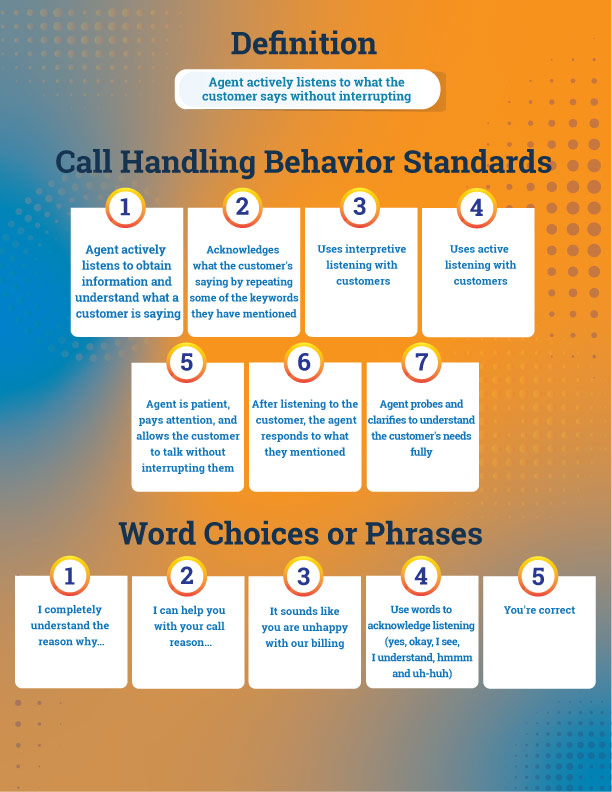
9. Call Length
SQM's call center industry research shows that the Csat rate is impacted by call length. Our CX survey research indicates that the Csat rate goes down the longer the call length. For example, the Csat (top box response) rate for the 1 to 3-minute call length is 82% versus the more than 15-minute call length, where the Csat rate is 76%. The Csat rate difference between the lowest call length (1 to 3 minutes) and the highest call length (more than 15 minutes) is 6%. Most call lengths are between 5 to 9 minutes. The call center industry average Csat benchmark rate is 78%.
The average handle time (AHT) call length (talk and wrap up) is approximately seven minutes. Customers prefer a live hold practice, meaning they can speak to the agent at any time during the call, versus a mute hold practice that does not allow them to talk to the agent. Another critical finding around the live hold practice is that call length is shorter with a live hold versus a mute hold. The shorter AHT is because the agent has a greater sense of urgency to resolve the call when the live hold business practice is used. To reduce call length, agents must be efficient with their support apps (e.g., CRM and KMT) and keep customers focused on resolving their call.
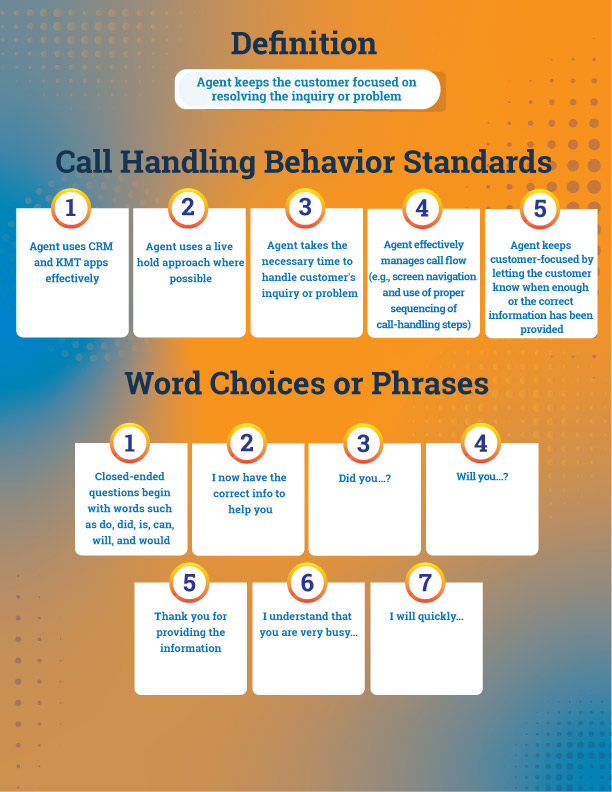
10. Understands the Reason for Call
To fully understand the customer's reason for their call, an agent determines and confirms the reason(s) for the customer's call by actively listening, probing, and clarifying to ensure understanding, acknowledging call history, and documenting the conversation with a CRM tool. Good knowledge of the customer's situation allows an agent to provide a personalized solution.
SQM describes customer handling skills as for the agent to have skills such as understanding the reason for the call, product and service knowledge, ability to process the call, being an advocate for the customer, and, most importantly, the ability to resolve the call. For example, to ensure an agent understands the customer's call reason, they confirm the reason why the customer called by restating keywords that the customer used.
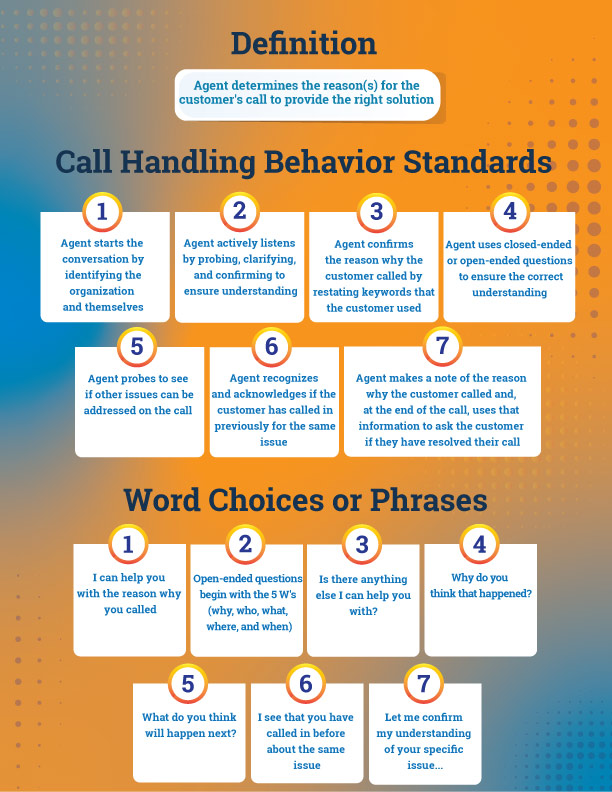
Quick Related Links
First Call Resolution Comprehensive Guide Top 10 Call Center Metrics Good to Great Customer Service Quality Assurance Agent Coaching VoC Coaching Agent Training Customer Satisfaction Comprehensive Guide
